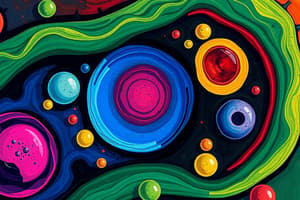Podcast
Questions and Answers
Which structure functions as the control center of the cell?
Which structure functions as the control center of the cell?
- Golgi Apparatus
- Mitochondria
- Nucleus (correct)
- Endoplasmic Reticulum
Which type of transport requires energy to move substances across the cell membrane?
Which type of transport requires energy to move substances across the cell membrane?
- Active transport (correct)
- Passive transport
- Facilitated diffusion
- Diffusion
What is the primary role of mitochondria in a cell?
What is the primary role of mitochondria in a cell?
- DNA replication
- Energy production (correct)
- Photosynthesis
- Protein modification
Which of the following is NOT a characteristic of prokaryotic cells?
Which of the following is NOT a characteristic of prokaryotic cells?
What is the primary function of ribosomes in a cell?
What is the primary function of ribosomes in a cell?
Which process results in the formation of genetically diverse gametes?
Which process results in the formation of genetically diverse gametes?
Chloroplasts are specifically involved in which of the following processes?
Chloroplasts are specifically involved in which of the following processes?
Which structure is responsible for modifying and packaging proteins?
Which structure is responsible for modifying and packaging proteins?
Homeostasis in a cell refers to which of the following?
Homeostasis in a cell refers to which of the following?
How do cells primarily communicate with each other?
How do cells primarily communicate with each other?
Flashcards are hidden until you start studying
Study Notes
Cell Structure
-
Basic Unit of Life: All living organisms are composed of cells.
-
Types of Cells:
- Prokaryotic Cells:
- No nucleus
- Smaller and simpler
- Example: Bacteria
- Eukaryotic Cells:
- Contain a nucleus
- Larger and more complex
- Example: Plant and animal cells
- Prokaryotic Cells:
-
Common Cell Organelles:
- Nucleus:
- Contains genetic material (DNA)
- Control center of the cell
- Mitochondria:
- Powerhouse of the cell
- Produces ATP through cellular respiration
- Ribosomes:
- Site of protein synthesis
- Can be free-floating or attached to the endoplasmic reticulum
- Endoplasmic Reticulum (ER):
- Rough ER: Studded with ribosomes; synthesizes proteins
- Smooth ER: Lacks ribosomes; synthesizes lipids and detoxifies
- Golgi Apparatus:
- Modifies, sorts, and packages proteins and lipids for secretion or use within the cell
- Lysosomes:
- Contains digestive enzymes to break down waste materials and cellular debris
- Chloroplasts (in plant cells):
- Site of photosynthesis
- Contains chlorophyll
- Cell Membrane:
- Semi-permeable barrier that controls the movement of substances in and out of the cell
- Composed of a phospholipid bilayer
- Nucleus:
Cell Function
-
Metabolism:
- All chemical reactions occurring within the cell
- Includes catabolism (breakdown) and anabolism (synthesis)
-
Protein Synthesis:
- DNA is transcribed to mRNA in the nucleus
- mRNA is translated to proteins at ribosomes
-
Cell Division:
- Mitosis: Division of somatic cells resulting in two identical daughter cells
- Meiosis: Division of germ cells resulting in four genetically diverse gametes
-
Transport Mechanisms:
- Passive Transport: Movement of substances without energy (e.g., diffusion, osmosis)
- Active Transport: Movement of substances against a concentration gradient using energy (e.g., sodium-potassium pump)
-
Communication:
- Cells communicate through signaling molecules and receptors
- Important for coordination and response to environmental changes
-
Homeostasis:
- Maintenance of stable internal conditions (e.g., temperature, pH)
-
Energy Production:
- ATP is produced primarily in mitochondria through cellular respiration
- In plants, energy is captured from sunlight through photosynthesis in chloroplasts
Cell Structure
-
Cells are the fundamental building blocks of all living organisms.
-
Prokaryotic cells:
- Lack a true nucleus, with genetic material dispersed in the cytoplasm.
- Generally smaller and simpler than eukaryotic cells.
- Example organism: Bacteria.
-
Eukaryotic cells:
- Have a distinct nucleus encasing their genetic material.
- Larger and more complex, containing various organelles.
- Examples include plant and animal cells.
-
Common cell organelles include:
- Nucleus: Acts as the control center, housing DNA and regulating cell activities.
- Mitochondria: Known as the powerhouse of the cell; generates ATP through cellular respiration.
- Ribosomes: Essential for protein synthesis; can either float freely in the cytoplasm or attach to the endoplasmic reticulum.
- Endoplasmic Reticulum (ER):
- Rough ER: Contains ribosomes and is involved in protein synthesis.
- Smooth ER: Lacks ribosomes; involved in lipid synthesis and detoxification processes.
- Golgi Apparatus: Modifies, sorts, and packages proteins and lipids for secretion or internal use.
- Lysosomes: Contain digestive enzymes that break down waste and cellular debris.
- Chloroplasts: Found in plant cells; responsible for photosynthesis and contain chlorophyll.
- Cell Membrane: Semi-permeable lipid bilayer regulating the movement of substances into and out of the cell.
Cell Function
-
Metabolism comprises all chemical reactions in the cell, including catabolism (breaking down molecules) and anabolism (building up molecules).
-
Protein synthesis involves:
- Transcribing DNA to mRNA in the nucleus.
- Translating mRNA to form proteins at ribosomes.
-
Cell division encompasses:
- Mitosis: Results in two identical daughter cells from somatic cells.
- Meiosis: Leads to four genetically diverse gametes from germ cells.
-
Transport mechanisms include:
- Passive transport: Moves substances without energy, such as diffusion or osmosis.
- Active transport: Requires energy to move substances against the concentration gradient, e.g., the sodium-potassium pump.
-
Cell communication occurs via signaling molecules and receptors, facilitating coordination and adaptive responses to environmental stimuli.
-
Homeostasis refers to the maintenance of stable internal conditions, such as temperature and pH balance.
-
Energy production:
- ATP synthesis primarily occurs in mitochondria through cellular respiration.
- In plants, chloroplasts capture sunlight to convert to energy during photosynthesis.
Studying That Suits You
Use AI to generate personalized quizzes and flashcards to suit your learning preferences.




